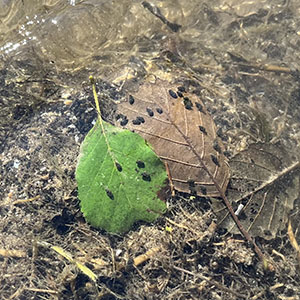Periphyton growth on allochthonous input in streams may lead to higher individual growth rates of the invasive New Zealand mud snail (Potamopyrgus antipodarum)

Submitted: 9 August 2022
Accepted: 25 May 2023
Published: 20 June 2023
Accepted: 25 May 2023
Abstract Views: 979
PDF: 293
HTML: 13
HTML: 13
Publisher's note
All claims expressed in this article are solely those of the authors and do not necessarily represent those of their affiliated organizations, or those of the publisher, the editors and the reviewers. Any product that may be evaluated in this article or claim that may be made by its manufacturer is not guaranteed or endorsed by the publisher.
All claims expressed in this article are solely those of the authors and do not necessarily represent those of their affiliated organizations, or those of the publisher, the editors and the reviewers. Any product that may be evaluated in this article or claim that may be made by its manufacturer is not guaranteed or endorsed by the publisher.
Similar Articles
- Amaia Pérez-Bilbao, Cesar João Benetti, Josefina Garrido, Aquatic Coleoptera assemblages in protected wetlands of North-western Spain , Journal of Limnology: Vol. 73 No. 1 (2014)
- Michela Rogora, Lyudmila Kamburska, Rosario Mosello, Gabriele Tartari, Lake Orta chemical status 25 years after liming: problems solved and emerging critical issues , Journal of Limnology: Vol. 75 No. s2 (2016): Lake Orta: a new lease on life
- Armine Hayrapetyan, Gor Gevorgyan , Martin Schultze, Muhammed Shikhani, Termine Khachikyan, Aleksandr Krylov, Karsten Rinke, Contemporary community composition, spatial distribution patterns, and biodiversity characteristics of zooplankton in large alpine Lake Sevan, Armenia , Journal of Limnology: Vol. 81 No. s1 (2022): Lake Sevan. Past, present, and future state of a unique alpine lake
- Flávio H. Ragonha, Alice M. Takeda, Does richness of Oligochaeta (Annelida) follows a linear distribution with habitat structural heterogeneity in aquatic sediments? , Journal of Limnology: Vol. 73 No. 1 (2014)
- Fabien Bourinet, Orlane Anneville, Hilaire Drouineau, Chloé Goulon, Jean Guillard, Alexandre Richard, Synchrony in whitefish stock dynamics: disentangling the effects of local drivers and climate , Journal of Limnology: Vol. 82 (2023)
- Elisa A. C. C. Alvim, Tiago B. Kisaka, Gabriela B. Nardoto, Luciana de Mendonça-Galvão, Barbara M. Fonseca, Mercedes M.C. Bustamante, Trophic relationships between primary producers and associated fauna in a pristine Cerrado pond , Journal of Limnology: Vol. 78 No. 3 (2019)
- Michela ROGORA, Julieta MASSAFERRO, Aldo MARCHETTO, Gabriele TARTARI, Rosario MOSELLO, The water chemistry of some shallow lakes in Northern Patagonia and their nitrogen status in comparison with remote lakes in different regions of the globe , Journal of Limnology: Vol. 67 No. 2 (2008)
- Liisa Nevalainen, Tomi Petteri Luoto, Sedimentary chydorid (Cladocera) ephippia in relation to lake ecological quality in the Austrian Alps , Journal of Limnology: Vol. 72 No. 1 (2013)
- Renata Trevisan, Marco Picarella, Frank B. Dazzo, Stefano Bona, Giuseppe Morabito, Andrea Squartini, Using a morpho-functional approach to assess phytoplankton dynamics in two adjacent high-mountain lakes: a 10-year survey , Journal of Limnology: Vol. 73 No. 3 (2014)
- Brigitte LODS-CROZET, Olivier REYMOND, Bathymetric expansion of an invasive gammarid (Dikerogammarus villosus, Crustacea, Amphipoda) in Lake Léman , Journal of Limnology: Vol. 65 No. 2 (2006)
<< < 23 24 25 26 27 28 29 30 31 32 > >>
You may also start an advanced similarity search for this article.

 https://doi.org/10.4081/jlimnol.2023.2092
https://doi.org/10.4081/jlimnol.2023.2092





